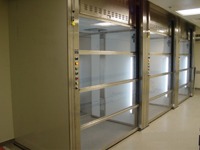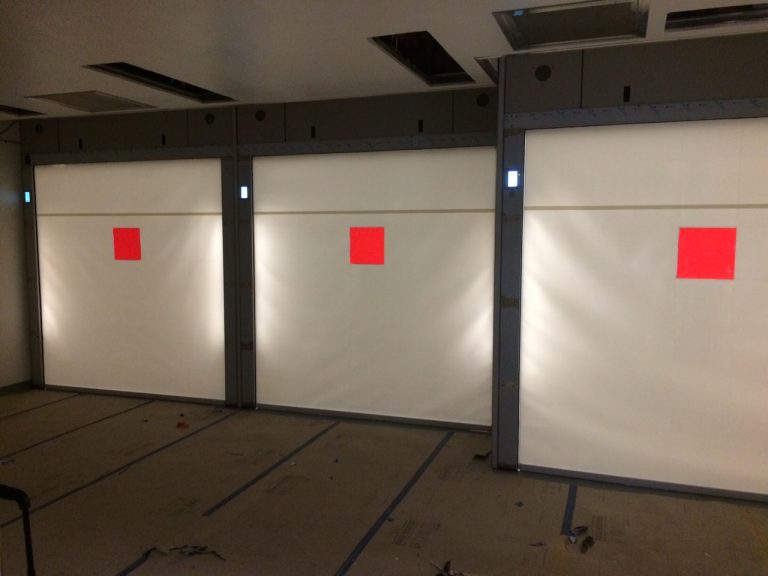The Problem:
Old Telescoping Doors
Britz still makes the traditional telescoping glass doors that have been an industry standard for isolation and containment for laboratory animal facilities for more than a half-century. Although vertically rising and telescoping doors have been shown to be the most effective door for animal cubicles, they are not without issues.

Glass doors tend to be heavy and require a significant amount of counterweight, especially if they are manually operated. These weights must be hidden in large door jambs, eating precious facility space. The counterweight cables can break and are difficult to repair.
be especially problematic for older facilities designed with low ceilings.Glass doors also require a lot of overhead space for “storage” when the doors are opened. Typically, if you want 84 inches of headspace inside the cubicle, then you need an additional 25-30 inches above, just to store the doors. This makes it difficult to install cubicle doors in rooms with ceilings that are less than 111-112 inches. This can
Telescoping doors can be very noisy, too. Manual doors can bang together as they are raised and lowered, and powered doors require large industrial motors. Banging, motor noises, and vibration can be very disturbing to animals housed inside the cubicle space.
Because the glass doors are solid, there is no clear visual indicator that the cubicle space is under proper differential pressure. Without a magnehelic of digital readout, there is no way to tell if the cubicle space is under a positive or negative differential; which is, of course, the cubicle’s primary purpose.
The Solution:
New Roll-Up Doors
In 2013, Britz & Company completed the development of a new, roll-up isolation cubicle door and presented it at the National AALAS meeting in Baltimore. It’s the first major “revolution” i n cubicle doors in over 20 years.
n cubicle doors in over 20 years.
Primarily composed of a single piece of flexible, PVC-coated fabric, the door rolls up quietly and stores neatly in a 4×4 stainless steel case. This means that the overall height of the cubicle can be reduced significantly. An 8-foot high cubicle can now be installed in older, ceiling-challenged facilities. And, with no counterweights to be hidden, the side jams can be significantly smaller and cleaner.
Because the door is a single piece of fabric, it operates super quietly and with very little vibration. The drive motor is housed inside the same case as the door itself, which further isolates noise from sensitive animal populations.
Similar to a flexible film isolator, the roll-up door gives a clear visual indicator that it’s doing its job. The door will bow slightly under negative differential, and outward under positive pressure. You know at a glance that your cubicle is working properly.
